The 2011 Mid-Range SSD Roundup: 120GB Agility 3, Intel 510 and More Compared
by Anand Lal Shimpi on June 7, 2011 12:52 PM ESTA year ago whenever I'd request an SSD for review I'd usually get a 128GB drive built using 3x nm 4GB 2-bit MLC NAND die. These days the standard review capacity is twice that as most drives ship with 25nm NAND, using 8GB die. Seeing a bunch of scores for 240GB+ drives however is frustrating to all involved. At these capacities you're almost always looking at two die per NAND device, which has significant performance benefits due to interleaving. Most SSD controllers have eight NAND channels and with sixteen NAND deviecs with two die per device that's four NAND die that the controller can interleave access between for each channel. The 128GB drives by comparison halve the number of NAND, which only allows the controller to interleave requests among two die.


How read interleaving works on a single channel
Not only are these 240GB+ drives the best case performance you'd see from a particular SSD, they are also very expensive. At around $2/GB you're looking at over $500 for a high end 240GB+ SSD. I've spent the past few weeks gathering modern SSDs with 128GB of NAND on-board to provide a look at a more balanced point in the price/capacity spectrum.
| Mid-Range 2011 SSD Roundup | ||||||||
| Specs (6Gbps) | Corsair P3 128GB | Crucial RealSSD C300 128GB | Intel SSD 320 160GB | Intel SSD 510 120GB | OCZ Agility 3 120GB | OCZ Vertex 3 120GB | ||
| Controller | Marvell 6Gbps | Marvell 6Gbps | Intel 3Gbps | Marvell 6Gbps | SF-2281 | SF-2281 | ||
| Raw NAND Capacity | 128GB | 128GB | 176GB | 128GB | 128GB | 128GB | ||
| Spare Area | ~6.9% | ~6.9% | ~15.3% | ~12.7% | ~12.7% | ~12.7% | ||
| User Capacity | 119.2GB | 119.2GB | 149.0GB | 111.8GB | 111.8GB | 111.8GB | ||
| Number of NAND Devices | 8 | 16 | 12 | 16 | 16 | 16 | ||
| Number of die per Device | 4 | 2 | 1 - 2 | 2 | 1 | 1 | ||
| NAND Type | 32nm Toggle | 34nm ONFI 2.0 | 25nm ONFI 2.1 | 34nm ONFI 1.0 | 25nm ONFI 2.1 | 25nm ONFI 2.1 | ||
| Street Price | $229.99 | $234.99 | $304.99 | $284.49 | $279.99 | $252.99 | ||
| Cost Per GB | $1.797 | $1.836 | $1.906 | $2.222 | $2.187 | $1.976 | ||
Corsair Performance Series 3
The first drive in the roundup is the one I've had the longest: Corsair's P3.
The P3 is based on the same Marvell controller used by Crucial in the C300 and Intel's SSD 510, however it's using what appears to be Marvell's standard firmware and as of yet Corsair hasn't provided any firmware updates to the drive. Internally the P3 uses 32nm Toshiba NAND on a very small PCB:
There are 8 NAND devices, making this a fully populated controller. Each NAND device has four 32nm die internally:
At $229.99 the P3-128 is the most affordable drive in our roundup, and it's a 6Gbps drive so it should be able to post some pretty high sequential numbers.
Crucial RealSSD C300
The C300 is nothing new, we reviewed this drive last year. I still don't have a 128GB version of the updated m4, however as we discovered in our review of the 256GB m4, performance isn't necessarily better than the C300. In many cases the m4 is actually slower than the C300.
The 128GB drive uses Marvell's 6Gbps controller (with Micron's own firmware) and features 34nm ONFI 2.0 NAND:
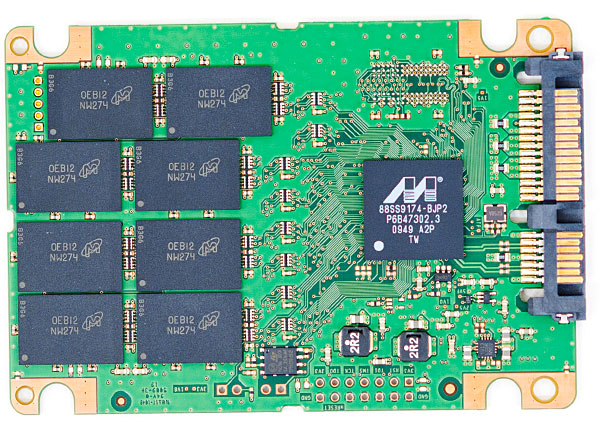
With sixteen NAND devices on the PCB, each package has two 4GB die inside it.
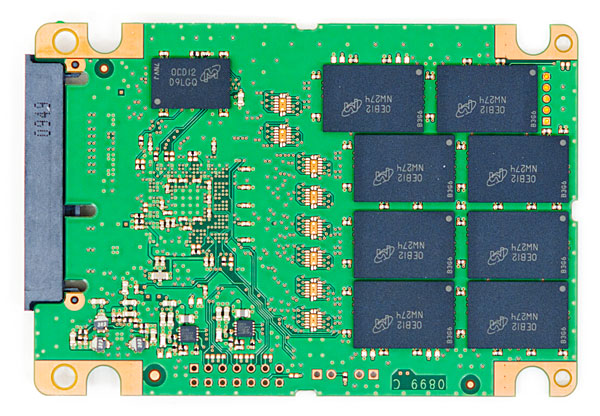
The C300 is pretty affordable by today's standards. The 128GB drive we tested here is selling for $234.99.
Intel SSD 320
Based on Intel's X25-M G2 controller but with new firmware the 320 adds features like real time encryption, however 6Gbps isn't in the cards with this drive:
Intel sent along the 160GB version of the 320, which has a pretty unusual NAND configuration. Remember Intel's controller is a 10-channel architecture and on the front of the PCB we have ten 25nm NAND devices:
These are 16GB NAND devices (two 8GB NAND die per package). That alone is good for the 160GB drive capacity, but the 320 needs more spare area than its predecessor so 160GB won't cut it. Flip the PCB over and you see two 8GB NAND devices:
I'm not entirely sure how Intel is striping data across all of the NAND. It's likely that Intel is simply just interleaving more operations on two of the channels. The 160GB 320 is the most expensive drive here at $304.99, but that's mostly because of the drive's capacity. In terms of cost per GB, the 320 is middle of the road here at $1.906 per GB.
Intel SSD 510
While the 320 is Intel's mainstream drive, the 510 is the high performance 6Gbps offering for enthusiasts. Intel is using Marvell's 6Gbps controller, again with its own custom firmware. The drive uses Intel's 34nm NAND and doesn't support the encryption features of the 320.
Since it uses 34nm NAND, Intel has 16 NAND devices internally each with two 4GB die:
The 510 is our second most expensive drive here at $284.49 and the most expensive on a cost-per-GB basis as well ($2.222):
OCZ's Agility 3 & Vertex 3
OCZ was the first to ship a SF-2281 based drive and now there are multiple offerings in the OCZ lineup. The Vertex 3 uses 25nm IMFT synchronous NAND, while the Agility 3 uses 25nm IMFT asynchronous NAND. As I hinted at in our review of the 240GB Agility 3, I fully expect a lot of pricing fluctuation between these two lines depending on availability of NAND. As a result, today you can buy a Vertex 3 from Newegg for less than you can an Agility 3. Obviously at the same price the Vertex 3 is the recommended drive but I expect to see these two flip flop more in the future.
Internally the Agility 3 (and Vertex 3) use 16 NAND devices with one die per device:
OCZ is very aggressive on Vertex 3 pricing, you can get the 120GB version today for $252.99.
The Test
| CPU |
Intel Core i7 965 running at 3.2GHz (Turbo & EIST Disabled) Intel Core i7 2600K running at 3.4GHz (Turbo & EIST Disabled) - for AT SB 2011, AS SSD & ATTO |
| Motherboard: |
Intel DX58SO (Intel X58) Intel H67 Motherboard |
| Chipset: |
Intel X58 + Marvell SATA 6Gbps PCIe Intel H67 |
| Chipset Drivers: |
Intel 9.1.1.1015 + Intel IMSM 8.9 Intel 9.1.1.1015 + Intel RST 10.2 |
| Memory: | Qimonda DDR3-1333 4 x 1GB (7-7-7-20) |
| Video Card: | eVGA GeForce GTX 285 |
| Video Drivers: | NVIDIA ForceWare 190.38 64-bit |
| Desktop Resolution: | 1920 x 1200 |
| OS: | Windows 7 x64 |


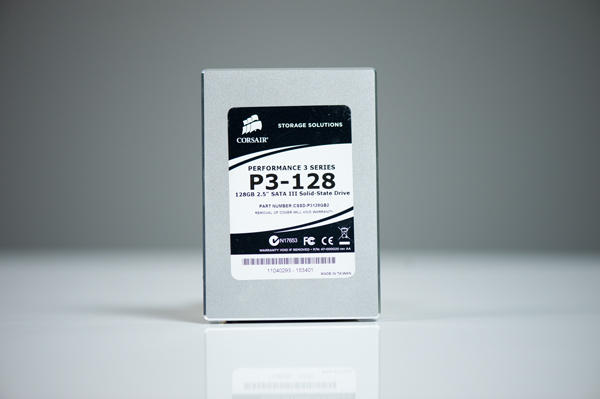
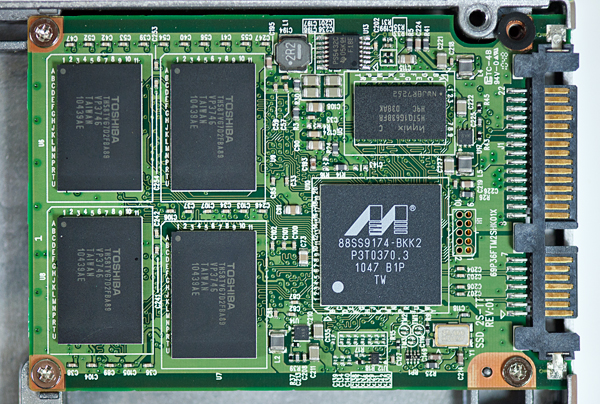


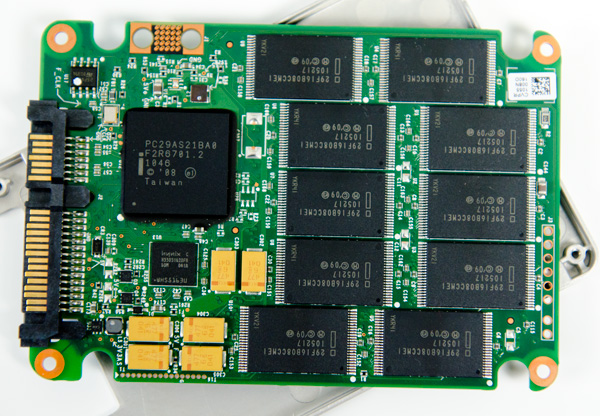
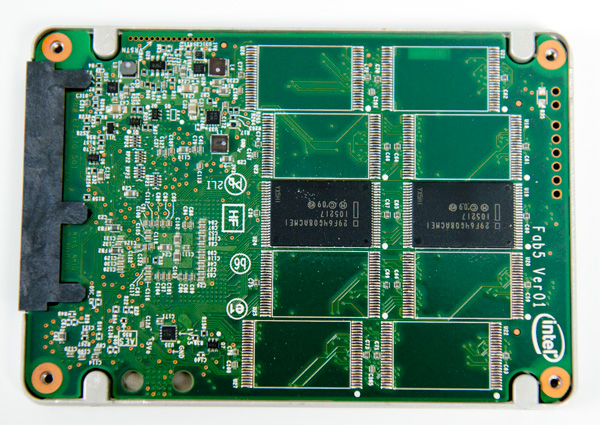
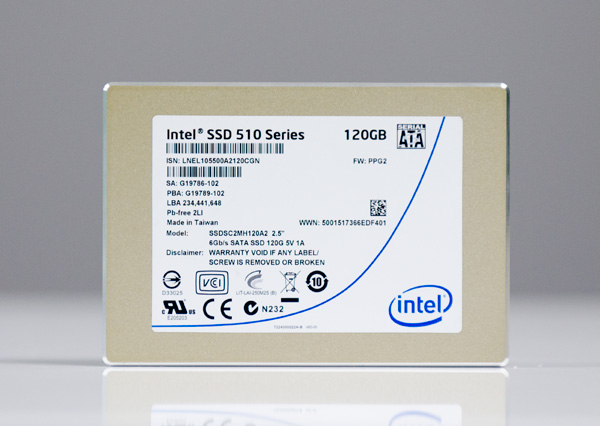
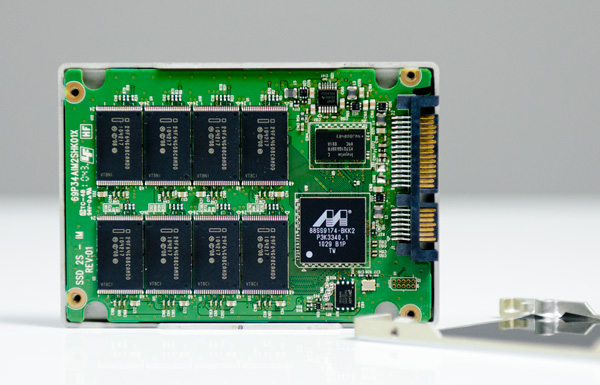

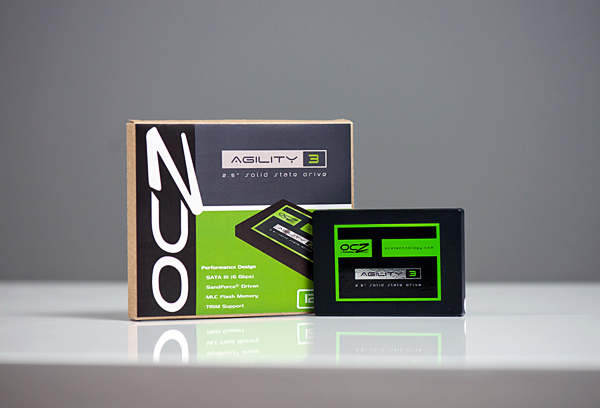
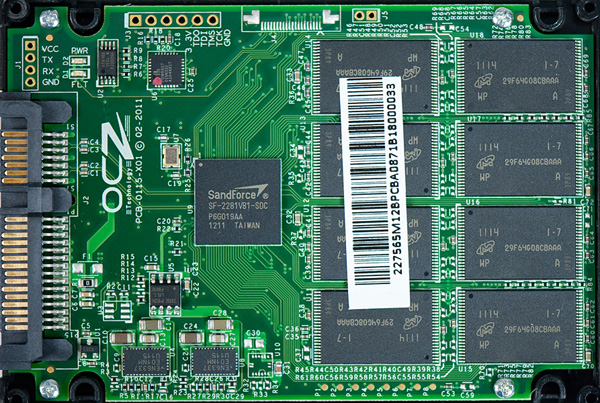
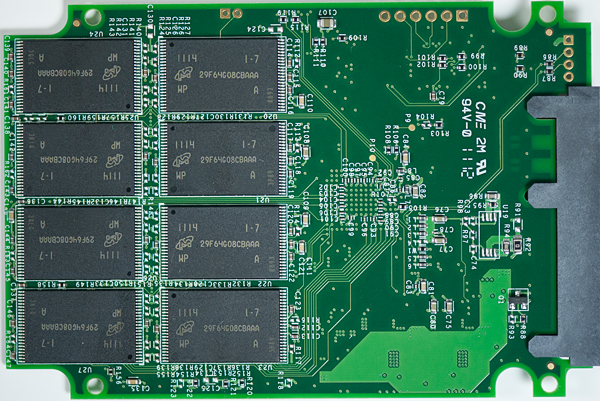








68 Comments
View All Comments
johan851 - Tuesday, June 7, 2011 - link
I've been wanting a comparison like this for a couple of weeks now, and I'm really glad you provided one. Thanks!Oxford Guy - Thursday, June 9, 2011 - link
Now if we could get a review with the 240 GB Vertex 2.That has been as low as $309 AR at MicroCenter. Yet, despite being able to be found for low prices ($350 AR lately), it's still nowhere to be found in reviews here.
shamans33 - Tuesday, June 7, 2011 - link
I just bought one for $220 before a $20 MIR about 2 weeks ago.Furthermore, your OCZ Agility 3 price is more expensive than the OCZ Vertex 3 price.....
Might want to look into getting pricing from a variety of vendors.
Anand Lal Shimpi - Tuesday, June 7, 2011 - link
Updated :)aegisofrime - Tuesday, June 7, 2011 - link
You updated the price but not the price per GB. :pI haven't had time to read through the whole article as I have to sleep now, so forgive me if my following question was addressed in the article. I'm considering a 120GB Intel 320, and I'm wondering will performance be lower than the 160GB version?
cactusdog - Wednesday, June 8, 2011 - link
Why no Corsair force 3 drives? Or mushkin ChronosFallen Kell - Wednesday, June 8, 2011 - link
They were all just recalled, that is why.http://forum.corsair.com/v3/showthread.php?t=95825
Shadowmaster625 - Tuesday, June 7, 2011 - link
No wonder intel was in no hurry with sata6. Half a watt extra power consumption at idle? Will that be the same for notebooks and tablets? If so then that is a serious problem. Why would power consumption be different at idle anyway?imaheadcase - Tuesday, June 7, 2011 - link
I read sometime back that intel drives performance might suffer simply because of power issues itself. Nothing bad mind you, just that its standby mode interferes with transferring data somewhat. Not sure if thats a firmware or just config error.Jaybus - Friday, June 10, 2011 - link
Because, even though sata6 has improved power management, the higher clock rate simply requires more power. Even at idle, there has to be some communication between the SSD and the SATA host controller. Primarily, it is up to the OS to put the SATA link into sleep mode. In general, sata6 will always use more power than sata3, since you can't get around the physics. Clocking faster requires either more power or a complete paradigm shift to an optical PHY.